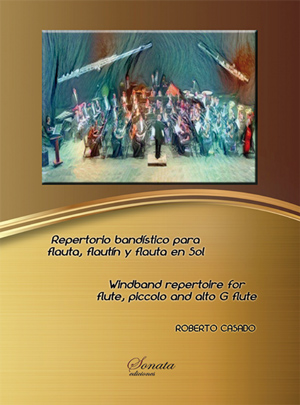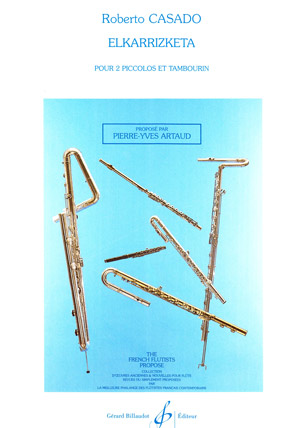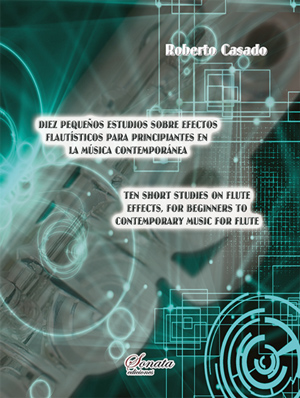WORKS

The band music in Spain is very common and popular, especially in the Mediterranean coast, where each village usually has one. These are non professional and have a great number of components. But this is not only common in the Mediterranean coast but in the rest of Spain, Europe and USA among other countries.
The repertory for band music usually includes the original music made for them, with transcriptions of great symphonic works, symphonic-chorals, operas, zarzuelas, etc…
This current compilation refers to the most important band solo repertory. Nowadays there is no work realized for this matter. On the other hand, there are a great number of works or compilations made on the subject of orchestra solos. Therefore, due to the lack of serious studies about this matter we have proceeded to investigate and analyse the fragments of the most important music solos for band.
In this volume you will find the most important band solos for flute, piccolo and alto flute. We have divided it in two parts for of each of the three instruments. Thus, you can find solos of original works for band and solos for orchestra band, chorals etc…transcripts or adapted to the band.

For this composition, I have chosen two piccolos and a small drum because the piccolo is the instrument that sounds more similar to the timbre of the txistu. The txistu is an instrument that belongs to the Basque folklore. It consists of a tube made of ebony with a bevelled mouth piece, like the recorder. It has three holes for the fingers. You play it with one hand, using the other one to play the percussion instrument or small drum, which belongs also to the Basque Folklore.
I dedicate the work to my niece and nephew, who are symbolized by two voices. It describes, with added percussion, a part of the Basque culture throughout the composition. The Basque region and culture appear in each movement and I have also used its own language.
The piece is structured with an introduction, and then a theme with five variations in D minor. It ends with a march in D major. In order to symbolize even more the Basque culture, I wanted to include in each part a dance or a description of a typical Basque sport.
Therefore, the composition begins with a very expressive introduction which has to be played with much sentiment. It is in 2/4 and it ends with a semi-cadence to approach the theme directly.
The theme is a dance called "zortziko", which is characterized by its irregular 5/8 rhythm.
The first variation is a new dance, the "fandango". This dance is of a ternary character and a fast tempo.
In the second variation, I deal with one of the most popular Basque sports, the "aizkolariak" (wood cutters). Each one of the two voices represents an "aizkolari" with its axe, and each quaver shows the hit of the axe cutting the trunk. In this variation, I have tried to reflect the dialogue between the two "aizkolariak".
The third variation deals with another Basque sport or "traineras". A "trainera" is a long boat. A few men row facing the rear of the boat while one leads the way to go in the competition. This variation represents the movement of the paddles.
The title of the fourth movement means Landscape of Euskal Herria. It is a variation in a slow tempo which takes us to one of the green landscapes of this region, with its villages, forests, mounts, and typical houses...
The fifth variation describes another Basques sport, the "txinga". It consists of people holding a race while holding a heavy object in each arm.
The last movement is a new dance, the "kalejira" or "dance in the street". It is a joyful music with a fast rhythm that ends the composition.

The 10 small studies on flute effects for beginners is destined for those people who wish to play contemporary music, but before doing so need to learn and practise the most usual flautist effects that are generally found in works. These studies are very brief so that the introduction and practising in this world of sounds does not become too hard.
The LOGSE (the law of Spanish musical curriculum requirements) establishes in its objectives and contents the study and practice of contemporary music. However, the pedagogic material in the market of elementary or initiation levels in this field is rather limited. For this reason, this educational work tries to contribute to fill this void which one finds with regard to didactic material, and put into the hand of both professionals and pupils a method to be able to proceed with the practise of studying this area.
This method consists of 8 small brief studies (wind noises, fruhlato or flutter-tonguing, percussiveness of hitting the keys, pizzicato or slap, different kinds of noises and the employment of the voice, circular breathing, glissandi and harmonica), which serve to practise in a quick way the different flautist effects which are used in the performance of contemporary music. Each piece is conceived for the practise of one of these flautist effects. I have selected the most important effects as I see it, for there are indeed rather more than I have collected here.
The metronome tempo markings established in each of the studies could be modified to be able to work in a more comfortable manner and therefore make easier their practise. Also one might trim the work of each study by fragments, or even taking a certain bar of it as a preliminary exercise.
